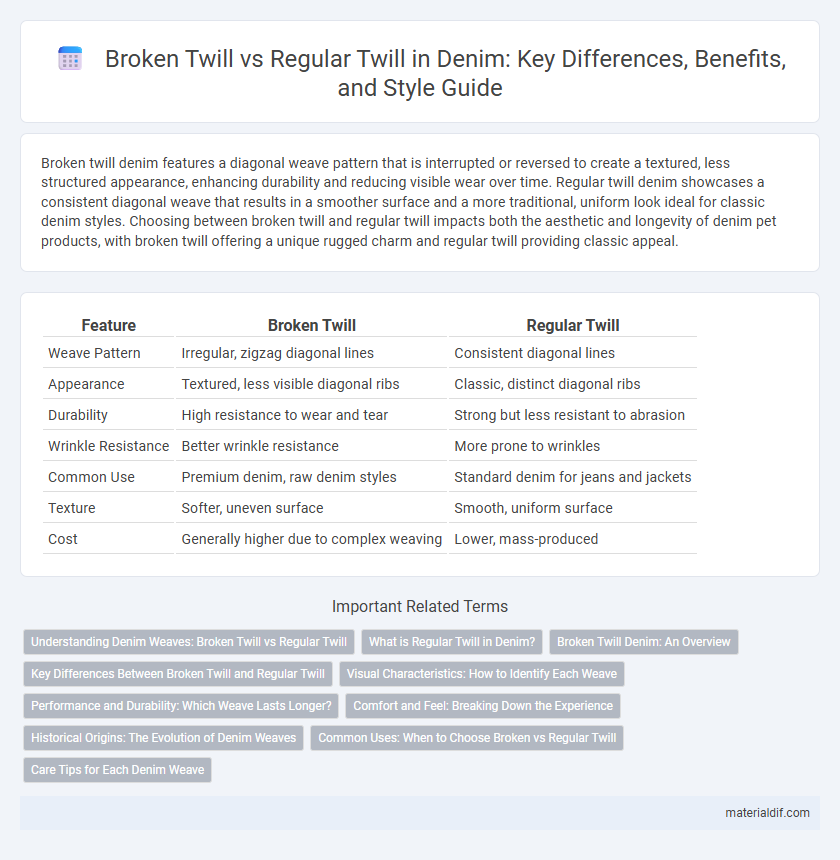Broken twill denim features a diagonal weave pattern that is interrupted or reversed to create a textured, less structured appearance, enhancing durability and reducing visible wear over time. Regular twill denim showcases a consistent diagonal weave that results in a smoother surface and a more traditional, uniform look ideal for classic denim styles. Choosing between broken twill and regular twill impacts both the aesthetic and longevity of denim pet products, with broken twill offering a unique rugged charm and regular twill providing classic appeal.
Table of Comparison
| Feature | Broken Twill | Regular Twill |
|---|---|---|
| Weave Pattern | Irregular, zigzag diagonal lines | Consistent diagonal lines |
| Appearance | Textured, less visible diagonal ribs | Classic, distinct diagonal ribs |
| Durability | High resistance to wear and tear | Strong but less resistant to abrasion |
| Wrinkle Resistance | Better wrinkle resistance | More prone to wrinkles |
| Common Use | Premium denim, raw denim styles | Standard denim for jeans and jackets |
| Texture | Softer, uneven surface | Smooth, uniform surface |
| Cost | Generally higher due to complex weaving | Lower, mass-produced |
Understanding Denim Weaves: Broken Twill vs Regular Twill
Broken twill denim features a zigzag pattern that reduces diagonal lines, resulting in less visible wear and enhanced durability compared to regular twill's consistent diagonal weave. Regular twill denim is characterized by a uniform right-hand diagonal pattern, offering classic texture and pronounced fading over time. Understanding the differences in these denim weaves helps consumers choose fabrics based on appearance, longevity, and fade characteristics.
What is Regular Twill in Denim?
Regular twill in denim refers to a woven fabric pattern characterized by diagonal parallel ribs running from the bottom left to the top right, typically at a 45-degree angle. This classic weave provides denim with durability, a smooth surface, and a uniform appearance, making it a popular choice for traditional jeans and workwear. Unlike broken twill, regular twill maintains a consistent diagonal line, enhancing the fabric's strength and resistance to wear and tear.
Broken Twill Denim: An Overview
Broken twill denim features a unique weave pattern where the diagonal lines of the twill fabric are interrupted, creating a more textured and durable surface compared to regular twill. This construction enhances fabric strength and reduces the tendency for directional fading, making broken twill denim a preferred choice for rugged durability and distinctive visual appeal. Its intricate weave also contributes to increased flexibility and comfort, distinguishing it from the smoother, more uniform appearance of regular twill denim.
Key Differences Between Broken Twill and Regular Twill
Broken twill denim features a distinct zigzag pattern created by alternating the twill direction, offering greater resistance to sagging and creasing compared to the diagonal weave of regular twill. Regular twill denim displays a consistent diagonal pattern, which provides classic durability and a more defined texture but is prone to visible wear lines over time. The unique weave of broken twill enhances fabric stability and subtle visual variation, making it a preferred choice for garments requiring long-lasting structure.
Visual Characteristics: How to Identify Each Weave
Broken twill denim features a zigzag pattern where the diagonal lines change direction, creating a more textured and less uniform appearance compared to regular twill. Regular twill displays a clean, consistent diagonal ribbing that runs in one direction, giving it a smooth and classic look. Observing the diagonal weave closely helps in distinguishing broken twill's distinctive irregular angular design from the steady, straight lines of regular twill.
Performance and Durability: Which Weave Lasts Longer?
Broken twill denim features a zigzag weave pattern that enhances fabric flexibility and reduces stress points, improving overall durability compared to regular twill's diagonal rib structure. The irregular pattern in broken twill distributes wear more evenly, extending the lifespan of denim, especially under frequent use and washing. In contrast, regular twill may show wear more quickly along its consistent diagonal lines, making broken twill a superior choice for long-lasting performance.
Comfort and Feel: Breaking Down the Experience
Broken twill denim offers a softer, more flexible feel compared to regular twill, thanks to its diagonal weave pattern that reduces stiffness and increases breathability. This variation enhances comfort by allowing the fabric to mold more naturally to the body, reducing break-in time. Regular twill denim, with its tighter weave, provides a sturdier texture but often feels rougher and less forgiving during initial wear.
Historical Origins: The Evolution of Denim Weaves
Broken twill denim traces its origins to vintage workwear patterns from the early 20th century, designed to reduce wear and diagonal fading compared to traditional regular twill. Regular twill features a consistent diagonal weave, historically used since the inception of denim in the late 19th century, providing durability and a characteristic fade pattern. The evolution from regular to broken twill weaves reflects denim's adaptation to both functional workwear needs and fashion-driven aesthetic preferences.
Common Uses: When to Choose Broken vs Regular Twill
Broken twill denim is favored for its diagonal weave pattern that reduces fabric distortion, making it ideal for garments requiring high durability and resistance to creasing, such as workwear and rugged jeans. Regular twill denim offers a classic diagonal texture that provides a smoother finish and greater flexibility, perfect for fashion-forward denim pieces and casual wear. Choosing broken twill suits projects needing structural integrity and less visible wear, while regular twill excels in styles prioritizing comfort and traditional aesthetic appeal.
Care Tips for Each Denim Weave
Broken twill denim features a unique diagonal weave that resists creasing and fading, requiring less frequent washing and gentle cold water cycles to maintain its texture. Regular twill denim, with its classic diagonal pattern, benefits from turning inside out before washing to protect the indigo dye and reduce color loss. Both weaves should be air-dried and avoided in high heat to preserve fiber integrity and prolong garment lifespan.
Broken twill vs Regular twill Infographic

 materialdif.com
materialdif.com